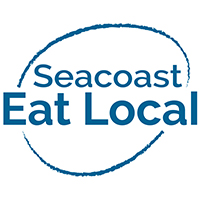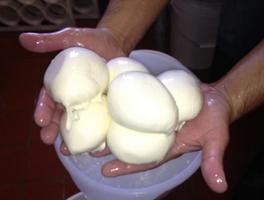Written by Kelsey MacDonald
Seacoast Eat Local Intern
Dairy products provide many essential nutrients, especially those associated with bone health. Calcium is a mineral known for building strong bones and teeth and maintaining bone mass and density. Dairy is the primary source of calcium in most people’s diets. It is recommended that at least three servings should be consumed daily to satisfy the body’s needs. Potassium is also found in milk and yogurt and is known for helping maintain a healthy blood pressure. Vitamin D is found mainly in fortified dairy products and is an important vitamin for healthy bones by helping the body absorb calcium. The fat content of dairy varies greatly  depending if you choose whole, low-fat or skim milk. Lastly, dairy is a source of high quality or complete protein, meaning that it contains all of the essential amino acids our bodies need. According to the United States Department of Agriculture (USDA), “Intake of dairy products is linked to improved bone health, and may reduce the risk of osteoporosis.”
depending if you choose whole, low-fat or skim milk. Lastly, dairy is a source of high quality or complete protein, meaning that it contains all of the essential amino acids our bodies need. According to the United States Department of Agriculture (USDA), “Intake of dairy products is linked to improved bone health, and may reduce the risk of osteoporosis.”
At the market you will find a wide variety of dairy products and bi-products from both cows and goats. You will find raw milk, raw cream, whole and low-fat raw yogurt, low-fat keifer, fresh and aged cow’s milk cheeses, goat’s milk and goat’s cheese. With the milk, cream and keifer, you will have to plan on paying a bottle deposit. This ranges from $1.50-$2.50 depending on the product size, but is a sustainable packaging practice. See http://brandmoorefarm.com/, http://brookfordfarm.com/, http://www.jestafarm.blogspot.com/, http://www.wolfmeadowfarm.com/, and http://hickorynutfarm.com/ to plan ahead for your purchases and learn about the farm.
There is still a lot of controversy about raw milk and its safety for consumers; with many passionate groups fighting for and against the ability to buy it. The Center for Disease Control (CDC) and the Food and Drug Administration (FDA) claims that it is unsafe due to the potential disease causing pathogens present before the milk is heat treated. It is important to ensure your milk is coming from a licensed, clean and regularly inspected facility and from cows that are pasture-raised to reduce this risk. According to the Weston A. Price Foundation, milk “can be produced hygienically and benefits are destroyed in pasteurization.” It is also said that while pasteurization kills the bad bacteria, it also kills the good bacteria – hence leading to the continued debate. Raw cheddar cheese is approved in places where fresh raw dairy products are not permitted to be sold, but only if it is aged over 60 days because the longer fermentation period kills off any potential pathogens. While this is a very personal decision, it is important to know your farmer and their practices before buying their products.
Raw milk is also believed to have many health benefits over pasteurized and homogenized milk. You can ensure the milk’s freshness when buying directly from the farmer at the markets or at the farm itself. According to Brandmore Farm, “Many people find it easier to digest raw milk compared to pasteurized milk; it contains enzymes that help break down the milk and aids in the digestive process.” There is no processing; just filtration and cooling. When from grass-fed cows, it contains a high quantity of antimicrobials and a beneficial fatty acid known as conjugated linoleic acid (CLA) and omega-3’s fatty acids. It has a fat content of about 3.9 percent depending on the breed of cow or goat. This higher fat content gives it a full flavor, and leads to more satiety while providing beneficial nutrients. Without being homogenized, the fat globules float to the top and require the milk to be shaken to redistribute the fat before drinking.
Raw cream is especially exciting in the spring time when the cows are back on pastures. Cream is densely packed with nutritional value, including fat soluble vitamins and beneficial bacteria. It is great for making your own fresh butter and buttermilk, adding to coffee, cooking and whipping. The beneficial bacteria and enzymes aid in digestion, which are typically lost during heating through pasteurization.
Similarly, raw yogurt, whole and low-fat from cow’s and goat’s milk is packed with beneficial bacteria and enzymes, known as probiotics. Plain yogurt can be tangy, but allows for the opportunity to flavor it your own way if you’d prefer. It is also great to add to a smoothie, especially if you have any frozen berries from the summer! Keifer is similar to yogurt in the way that they are both cultured milk products, but keifer is drinkable and easier on the go. Because of the smaller curd size, keifer is easier to digest for all ages.
You can find specialty and artisan cheeses, both fresh and aged at the markets including, but not limited to; raw cheedar, camerbert, brie, feta, cottage, quark (plain, garlic and dill, and horseradish), fresh mozzarella, ricotta, caciocavallo, caciotta, scamorza, lacey white, terrene, and chebar. Each of these varieties has something special to offer. Many of the farms and cheese makers offer samples of their products and flavor profile descriptions at the market allowing you to make the best choice for your pallet.
Other dairy bi-products at the markets include goat milk soap, goat milk fudge, and maple ice cream in the summers.
Resources:
http://www.raw-milk-facts.com/what_is_in_raw_milk.html
http://drinc.ucdavis.edu/goat1.htm
http://nourishedkitchen.com/fresh-cream/
http://www.kefir.net/kefir-vs-yogurt/
http://www.choosemyplate.gov/food-groups/dairy-why.html
http://www.cdc.gov/foodsafety/rawmilk/raw-milk-index.html



